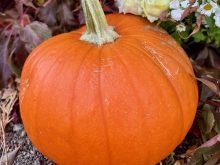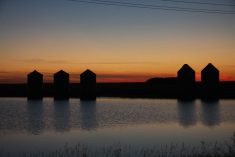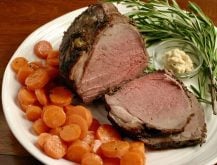We recently attended our friend Lyle’s third annual 60th birthday party. No, it isn’t a misprint – it was his third annual. The question is how old is he now? I bet you said 63. If so, calculate again. Most of us get caught.
The drive to Lyle and Carol’s farm was
delightful. So far, the crops in our area have had just the right amount of rain. I like to go for a drive and see the crops only when they are looking good, otherwise it is too depressing. The bright yellow canola fields were in full bloom, looking so majestic. It wasn’t that many years ago when canola was not a crop grown in our area, and so no yellow fields. New varieties, new ways of seeding, new sprays and other factors now make it possible to grow canola in west-central Saskatchewan. It certainly has enhanced the landscape.
Read Also

Rural Manitoba resources slim on natural disaster planning
A study from Brandon University’s Rural Development Institute has found that many rural and small municipalities don’t have the staff or resources to make formal climate plans against natural disaster.
Bread machines
Dear TEAM:
I recently acquired a bread machine. I’m having great fun with it. Could you recommend some bread machine cookbooks that I could request at the library? One recipe asks for seven grain cereal. Would anyone have an idea what that might be? I’ve looked in all the local stores for seven grain flour. I’m sure I had some years ago made by Robin Hood but can’t find any now. – E.M., Kinley, Sask.
The seven grain cereal called for in the recipe would be a cereal, and not ground as fine as flour. Bulk food sections of the supermarkets or bulk food stores usually carry a “many grain” cereal. It might be made of any combination of wheat, oats, barley, buckwheat, millet, rye, flax or spelt. Our local bulk store has an eight grain cereal.
You could also use any multi-grain cereal such as Red River or Sunny Boy. They are a three grain cereal made of wheat, rye and flax.
My favourite bread machine cookbook is Canadian Living’s Best Bread & Pizzas by Elizabeth Baird. Unfortunately it isn’t readily available so the best place to get one would be at a used bookstore. Many of the recipes in this book have the “make it by hand” and the bread machine methods.
The following tips might be helpful for adapting your favourite “made by hand” recipes to use in a bread machine.
- Using the manufacturer’s manual as a guide, determine the amount of flour (number of cups) that you can use in your bread machine. You must not exceed this amount or you might damage the machine.
- For each one cup (250 mL) of flour used, you will need approximately 1/3 cup (75 mL) of liquid, at least one teaspoon (five mL) sugar, honey or other sweetener, 1/4 teaspoon (one mL) salt and 1/2 teaspoon (two mL) dry yeast, either bread machine or quick-rising (instant). Do not leave out the sweetener or the salt because both are needed for a successful yeast dough.
- Have all ingredients at room temperature for best results.
- If fat is called for in the recipe, use at least one teaspoon (five mL) room temperature solid fat or vegetable oil per one cup (250 mL) flour.
- Remove the bread pan from the bread machine before adding any ingredients. Add ingredients to the pan in the order suggested by the machine’s manufacturer or according to the recipe you are following. Yeast must remain dry until the machine starts to mix ingredients.
- Be present when the bread machine starts to knead the ingredients. Open the lid and look at the dough ball during the first knead. If it is too firm and dry, or the bread machine seems to be straining, add a few drops of liquid to make it softer; if it is too sticky, add enough flour to make it smooth. Keep track of what you are adding and change your basic recipe for the next time. It might take a number of attempts to get the formula right.
Country seed bread
I liked the combination of seeds in this recipe. For a nuttier flavour, toast the seeds on a baking sheet in a 350 F (180 C) oven for four minutes. Let the seeds cool completely before using. I made the bread machine version and found it tasty.
2 cups all-purpose 500 mL
flour
1 cup whole wheat 250 mL
flour
1/4 cup flax seeds 60 mL
2 tablespoons sesame 30 mL
seeds
1 tablespoon poppy 15 mL
seeds
2 teaspoons quick-rising 10 mL
(instant) dry yeast
11/4 cups warm water 325 mL
2 tablespoons honey 30 mL
2 tablespoons vegetable 30 mL
oil
11/2 teaspoons salt 7 mL
In a large bowl, stir together all-purpose and whole wheat flours, flax, sesame and poppy seeds and yeast. In small bowl, whisk together water, honey, oil and salt; stir into flour moisture until sticky dough forms.
Turn out dough onto lightly floured surface. Knead for about eight minutes and add up to 1/4 cup (60 mL) more all-purpose flour as necessary. Place in a greased bowl, turning to grease all over. Cover with plastic wrap; let rise in warm draft-free place until doubled in bulk, about 11/4 hours.
Punch down dough; turn out onto lightly floured surface. Gently pull dough into 11 x eight inch
(28 x 20 cm) rectangle. Starting at one narrow end, roll up into a cylinder and pinch along bottom to smooth and seal. Fit into greased eight x four inch (1.5 L) loaf pan. Cover and let rise until doubled in bulk and about 3/4 inch (two cm) above rim of pan, about one hour.
Brush top of loaf with water. With a serrated knife, make a one inch (2.5 cm) deep cut lengthwise along the top of the loaf. Bake in centre of 400 F (200 C) oven for 15 minutes. Reduce heat to 350 F (180 C); bake for 30 to 35 minutes or until browned and loaf sounds hollow when tapped on bottom. Remove from pan; let cool on rack.
Makes one loaf, 12 slices.
Large machine method
Into the pan of a 11/2 to two pound (750 gram to one kilogram) machine, add (in order) water, honey, oil, salt, all-purpose and whole wheat flours, flax seeds, sesame seeds, poppy seeds and yeast. Do not let yeast touch liquid. Choose
appropriate setting (whole wheat, powdered milk). Let loaf cool on rack. Makes one loaf.
Small machine method
Into the pan of a one lb. (500 gram) machine, add (in order) 3/4 cup (175 mL) warm water, four teaspoons (20 mL) each liquid honey and vegetable oil, one teaspoon (five mL) salt, 11/3 cups (325 mL) all-purpose flour, 2/3 cup (150 mL) whole wheat flour, three tablespoon (45 mL) flax seeds, four teaspoons (20 mL) poppy seeds and 11/4 teaspoons (six mL) quick-rising instant dry yeast. Do not let yeast touch liquid. Choose appropriate setting (whole wheat, powdered milk). Let baked loaf cool on rack. Makes one small loaf, eight slices.
Source: Canadian Living’s Best Breads & Pizzas by Elizabeth Baird, 1998.
Wild rice salad
We recently enjoyed two days with Bill’s college classmates at Elbow, Sask. One evening was a potluck barbecue with many tasty dishes including this wild rice salad.
1 cup raw wild rice 250 mL
4 cups water 1 L
2 cups favourite 500 mL
vegetables
Put wild rice in a wire strainer and rinse with cold water. Combine rice and water in a saucepan and bring to a boil. Cover and reduce heat to gentle boil for 50-60 minutes until kernels puff open to reveal white interior. Drain. (If you soak overnight the cooking time will be reduced.) The rice will expand, making four cups (one L) of cooked wild rice.
Add about two cups (500 mL) of finely chopped vegetables to the cooked rice. This could include cauliflower, celery, dried cranberries, raisins, nuts, red yellow or green pepper, green onion and 1/4 cup (60 mL) finely chopped feta cheese. Drizzle a raspberry vinaigrette over rice and vegetables. Toss together.
Sunscreen tip
Store sunscreen in a cool, dry, dark place. Heat and humidity can reduce its potency. Most sunscreens have a three to five year shelf life, and some carry an expiration date. But keep in mind that if sunscreen is used properly, you need to apply a lot and frequently.
Alma Copeland is a home economist from Elrose, Sask., and one of four columnists comprising Team Resources. Send correspondence in care of this newspaper, Box 2500, Saskatoon, Sask., S7K 2C4 or contact them at team@producer.com.














